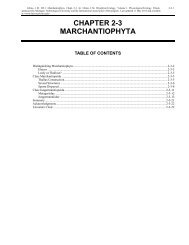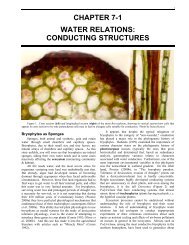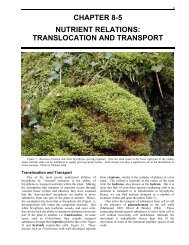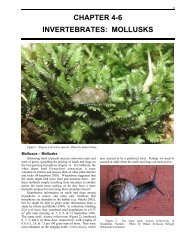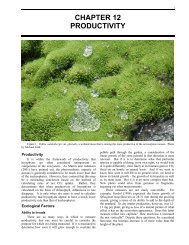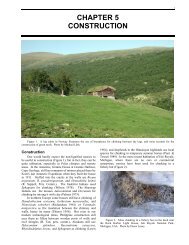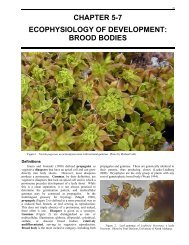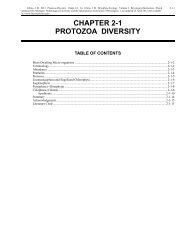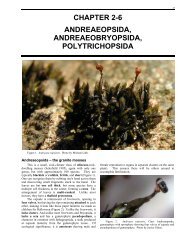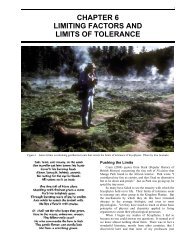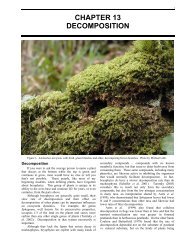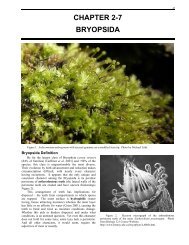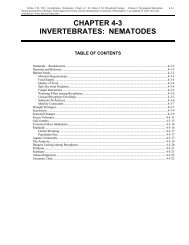Chapter 4-5 Invertebrates Rotifers - Bryophyte Ecology - Michigan ...
Chapter 4-5 Invertebrates Rotifers - Bryophyte Ecology - Michigan ...
Chapter 4-5 Invertebrates Rotifers - Bryophyte Ecology - Michigan ...
You also want an ePaper? Increase the reach of your titles
YUMPU automatically turns print PDFs into web optimized ePapers that Google loves.
4-5-22 <strong>Chapter</strong> 4-5: <strong>Invertebrates</strong>: <strong>Rotifers</strong>species, it must be quantifiable, and it should beeconomical in both equipment cost and time. <strong>Bryophyte</strong>samples 1 cm 2 should be shaken vigorously in a 70 ml vialwith 20 ml rainwater for 15 seconds. If the sample is dry, itshould soak for 24 hours in rainwater first. After shakingput the sample and water in a Petri dish with a grid. Thenput the moss back in the vial. <strong>Rotifers</strong> can be counted witha dissecting microscope at 40-50X. This should berepeated nine more times with material from the samesample, using a new Petri dish each time. From each ofthese samples, take 50 rotifers at random and make aseparate slide for each. These can be stored for weeks in amoist chamber.Summary<strong>Rotifers</strong> (Rotifera) can enter a state ofcryptobiosis (dormant state) and survive desiccationright along with bryophytes, also getting dispersed withthe fragments of mosses. The bdelloid rotifers are themost common among bryophytes and areparthenogenetic, hence are all female. In thepliomates, unfertilized eggs develop into a male. Inunfavorable conditions, pliomates form thick-walledresting "eggs" (really zygotes and embryos). Theydepend on water not only for hydration, but forlocomotion and directing food to the mouth using ciliain the corona.<strong>Rotifers</strong> are common on bryophytes, and in theAntarctic they are largely restricted to mosses inshallow water. They feed on bacteria and protozoatrapped by bryophyte leaves and gain protection therefrom predators. Habrotrocha roeperi and Habrotrochareclusa seem to be restricted to the retort cells of someSphagnum species. In aquatic habitats, thoseoccupying Fontinalis antipyretica can reach densities151 times that of adjacent mineral substrate. Hundredsof thousands can exist in 100 mL of this moss. Fineparticulate matter trapped by mosses can serve as food.When confronted with drying conditions, rotifersform a compact structure known as a tun. Slow dryingproduces the greatest survival and production of thedisaccharide sugar trehalose maintains membraneintegrity. Activity generally resumes within one hourof rehydration.<strong>Bryophyte</strong>-dwelling rotifers tend to be smallerthan those in water. Terrestrial bryophytes provideslow but unpredictable and frequent drying.The record survival for an egg appears to be nineyears, whereas an adult of Macrotrachelaquadricornifera survived dry on a moss on a herbariumsheet for 59 years. Mucous appears to deter predation,but it could also protect against dehydration.Tardigrades may be significant predators, butPtygura velata constructs a tube from its own feces forprotection. Some rotifers live in lobules of liverwortleaves (Frullania, Microlejeunea, Colura, Pleuroziapurpurea, Acrolejeunea) where desiccation is lessfrequent and there is a modicum of protection.In the Antarctic, many rotifers prefer the middlestem zone where epiphytic algae are most abundant. Inpeatlands, acidity seems to discourage many species,with more species and greater abundance in fens.AcknowledgmentsBryonetters have been wonderful in making theirphotographs available to me and seeking photographs fromothers. Robert Wallace helped me to understand the lifecycle and structures of the rotifers. Paul Davison has beenhelpful in providing suggestions and offering images. TomThekathyil alerted me to the image of a rotifer on aSphagnum cell and Des Callahan helped me find the emailaddress of the photographer. Tom Powers and WalterDioni helped me obtain images and permission from others.Many photographers have been generous with permissionfor the use of their images.Literature CitedAlpert, P. 2000. The discovery, scope, and puzzle of desiccationtolerance in plants. Plant Ecol. 151: 5-17.Barnhisel, D. R. 1991. The caudal appendage of the cladoceranBythotrephes cederstroemi as defense against young fish. J.Plankton Res. 13: 529-537.Barron, George. 2012. War of the Microworlds. Accessed 123May 2012 at.Bartos, E. 1949. Additions to knowledge of moss-dwelling faunaof Switzerland. Hydrobiologia 2: 285-295.Bateman, L. E. and Davis, C. C. 1980. The Rotifera ofhummock-hollow formations in a poor (mesotrophic) fen inNewfoundland, Canada. Internat. Rev. Gesamt. Hydrobiol.65: 127-153.Bateman, L. E. and Davis, C. C. 2007. The Rotifera ofhummock-hollow formations in a poor (mesotrophic) fen inNewfoundland. Internat. Rev. gesam. Hydrobiol. Hydrogr.65: 127-153.Bērziņš, B. and Pejler, B. 1987. Rotifer occurrence in relation topH. Hydrobiologia 147: 107-116.Bledzki, L. A. and Ellison, A. M. 2003. Diversity of rotifersfrom northeastern U.S.A. bogs with new species records forNorth America and New England. Hydrobiologia 497: 53-62.Burger, A. 1948. Studies on moss dwelling bdelloids (Rotifera)of eastern Massachusetts. Trans. Amer. Microsc. Soc. 67:111-142.Caprioli, M. and Ricci, C. 2001. Recipes for successfulanhydrobiosis in bdelloid rotifers. Hydrobiologia 446/447:13-17.Cavanihac, J.-M. 2004. The fascinating world of rotifers. basedon March 2004 edition of Micscape Magazine. Accessed 25January 2012 at .Charman, D. J. and Warner, B. G. 1992. Relationship betweentestate amoebae (Protozoa: Rhizopoda) andmicroenvironmental parameters on a forested peatland innorth-eastern Ontario. Can. J. Zool. 70: 2474-2482.Clément, P., Amsellem, J., Cornillac, A.-M., and Ricci, C. 1980.An ultrastructural approach to feeding behaviour inPhilodina roseola and Brachionus calyciflorus (rotifers) III.Cilia and muscles. Conclusions. Hydrobiologia 73: 137-141.Danchin, E. G. J., Flot, J.-F., Perfus-Barbeoch, L., and Doninck,K. Van. 2011. Genomic perspectives on the long-termabsence of sexual reproduction in animals. In: Pontarotti, P.(ed.). Evolutionary Biology – Concepts, Biodiversity,Macroevolution and genome Evolution. Springer, Berlin,Heidelberg, pp. 223-242.



